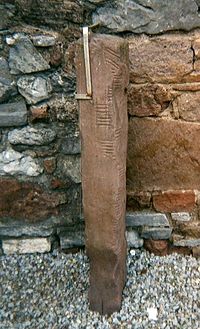Tag:historic=ogham_stone
Jump to navigation
Jump to search
| Description |
|---|
| A stone with an Ogham script on it. They are most commonly found in Ireland as free standing stones, lying on the ground, recycled in buildings such as churches or as artefacts in museums. |
| Group: historic |
| Used on these elements |
| Useful combination |
|
| Status: approved |
| Tools for this tag |
|
A stone with an Ogham script on it.
They are most commonly found in Ireland as free standing stones, lying on the ground, recycled in buildings such as churches or as artefacts in museums.
Usage
Set a node ![]() and add historic=ogham_stone. Add name=*, preferably using an established name used in research literature.
and add historic=ogham_stone. Add name=*, preferably using an established name used in research literature.
Examples
In this Time Team episode (Spoiler alert!) they find an stone that has ogham on it.
- Arraglen Ogham Stone on Wikipedia
- Ballycrovane Ogham Stone on Wikipedia
- Ballaqueeney Ogham Stone on Wikipedia
- Breastagh Ogham Stone on Wikipedia
- Dungummin Ogham Stone on Wikipedia
- Dunloe Ogham Stones on Wikipedia
- Kiltera Ogham Stones on Wikipedia
- Silchester Ogham stone on Wikipedia
Tags to use in combination
| How to tag | Example | Explanation |
|---|---|---|
| name | Arraglen Ogham Stone | Use a well established (with a compatible licence) and verifyiable (see source) name. If there is more than one ogham stone at the site, follow the numbering in the research literature.
|
| inscription=* | The text of the inscription in Ogham characters, as written on the stone. | |
| inscription:en=* | Translation of the inscription. | |
| inscription:pgl-Latn=* | QRIMITIR RO/Ṇ[A]/ṆN MAQ̣ COMOGANN |
Transcription of the text of the inscription in Latin alphabet |
| inscription:pgl-Ogam=* | The inscription in Ogham characters (see Wikipedia for unicode block.). This tag is purely optional, inscription=* is usually sufficient | |
| wikipedia=* | en:Arraglen Ogham Stone |
If this stone has a Wikipedia article |
| wikidata=* | Q48797670 |
If this stone has a WikiData entity |
| moved=* | If the stone has been moved from its original place, add moved=yes. moved=no (i.e. it has not been moved) should be assumed to be the default | |
| moved_to:wikidata=* | Q69379477
|
If the stone has moved, provide the Wikidata entity for its current location |
| moved_from=* | Verbal description of whence the stone was moved, i.e. presumed original location (townland and/or building and/or archaeological site | |
| moved_from:wikidata=* | Wikidata identifier for the original location | |
| height=*, width=* | height=1.91, width=0.38 |
|
| description=* | standing upright, 1.67m in height above ground |
|
| material=* | sandstone |
What type of stone is this (sandstone/ granite etc)? |
| source=* | survey | The source of the major part of tags |
| source:inscription=* | opendata |
If you haven't transcribed the inscription yourself, please give your source. |
| source:url=* | https://ogham.celt.dias.ie/stone.php?lang=en&site=Arraglen&stone=145._Arraglen&stoneinfo=description |
The URL of an external source consulted |
| ref:IE:nm=* | 221.01 |
If it is a National Monument in the Republic of Ireland, add its number here. |
| ref:IE:smr=* | KE025-002---- |
For the Sites and Monuments records number for the Republic of Ireland. |
| project=* | add this, if the entity belongs to a project, e.g. "ogham.link" | |
| wikimedia_commons=* | File:Coumeenoole_Ogham_Stone_(Dunmore_Head).jpg |
If this stone has a Wikimedia Commons entry (e.g. image) |
| url:sketchfab=* | |
Short link to the sketchfab url of the model. (blocked by this wiki, so example cannot be given here) |
External ressources
- UCC have a list of Ogham stones with description. If possible, follow their naming pattern when naming the Ogham stones.


